1-13~19 Flora and Fauna in Kushiro 3
1-13 Hornets and Their Nests
Hornets play an important role in controlling insect populations. There are several species of hornet in Kushiro, including one of the world’s largest, the Japanese giant hornet (Vespa mandarinia japonica). Among other species in the area are the Japanese yellow hornet (Vespa simillima simillima) and Asian yellowjackets (Vespula flaviceps).
Nest building
The wetlands are rich in nest materials such as decaying logs, tree bark, and dead grasses. Different species of hornet use different materials to build their nests, but the construction process is similar. After the queen emerges from hibernation, she builds several hexagonal cells from materials she has chewed into a pulp, then lays eggs. The eggs hatch into workers that collect materials to expand the nest, then build more cells. As the worker population grows, the nest expands gradually outwards, like a balloon. Unlike bees, hornets do not store honey inside their nests.
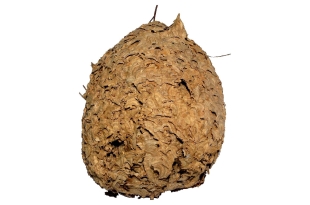
1-14 The Insects of Kushiro
Over 1,000 species of insects inhabit the Kushiro Wetlands. Many insect eggs and larvae spend the winter in stasis before hatching and emerging in late April. The warmer months of April to November are the best times to see the insects in the area.
An ideal breeding environment
The water and vegetation of the marsh support many species of insects, supplying food sources and shelter. Some species, such as the subarctic darner dragonfly (Aeshna subarctica), lay their eggs on mosses and sedges at the edges of swamps and bog ponds, where the larvae can feed on aquatic insects. Others inhabit higher ground, like the green hairstreak butterfly (Neozephyrus japonicus). It lays its eggs under the leaf buds of alder trees (Alnus japonica), which provide shelter and food.
The sounds of summer
Over the summer months, the sounds of various insect species can be heard around the Kushiro Wetlands. The yezoharuzemi cicada (Terpnosia nigricosta) starts to sing in late May, followed by the koezozemi cicada (Lyristes bihamatus) in late July. At the end of summer, the rasp of the long-horned grasshopper (Gampsocleis ussuriensis) fills the grasslands around the wetlands.
A life’s work
The insect specimens on display at the Kushiro City Museum are part of a much larger collection assembled by Ijima Kazuo (1928–2016), an expert on the insects of eastern Hokkaido. He collected and classified insects in the area for much of his life.
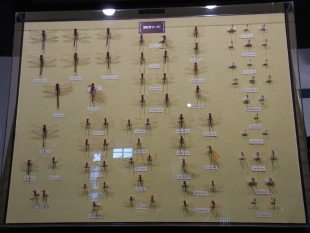
1-15 Yezo deer
The Yezo deer (Cervus nippon yesoensis) is a subspecies of Japanese deer found only in Hokkaido. The word yezo (sometimes ezo), which refers to Hokkaido, appears in the names of many animals that are endemic to the island.
The Ainu people traditionally hunted Yezo deer for food, but during the Meiji era (1868–1912), the animals were hunted to near extinction by settlers from the mainland. The settlers also hunted Hokkaido wolves (Canis lupus hattai), natural predators of the deer, driving them to extinction in Hokkaido in 1889.
Living in balance
The combination of a lack of predators, milder winters, and plentiful food from local farms allowed the Yezo deer population to recover, and their numbers have grown rapidly since the 1980s. Unfortunately, Yezo deer are destructive: they eat small plants and strip bark off trees, affecting the ecosystem. As a result, communities are using measures such as repellents, fences, and culling to manage the deer population.
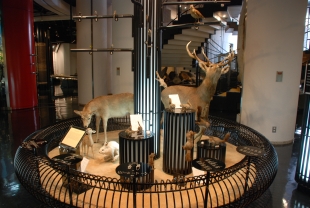
1-16 Brown Bears
The brown bear (Ursus arctos) is among the world’s largest bear species, second only to the polar bear in size. Brown bears are found across the Eurasian continent, as well as in North America (where they are called grizzly bears) and in Hokkaido. Hokkaido’s largest brown bear population is in Shiretoko, northeast of Kushiro.
Living gods
The indigenous Ainu people consider bears to be mountain gods (kimun kamuy in the Ainu language). Bears were traditionally hunted for fur and meat, which were regarded as gifts from the mountain gods. When a bear was killed, the Ainu people performed a ceremony to send the bear’s soul back to the realm of the gods.
A varied diet
Brown bears are omnivorous. Their diet includes salmon and trout, small mammals, and occasionally Yezo deer, as well as plants such as acorns, butterbur stalks, and fruit. Brown bears hibernate in caves through the winter, emerging from their dens in spring, around April or May. While brown bears and humans generally coexist peacefully, bear attacks are sometimes reported, and hikers should be cautious in forested areas.
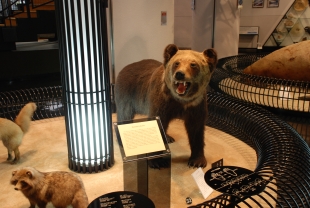
1-17 Endangered Bird Species within Kushiro
Kushiro and its surroundings are home to many rare and endangered animals. Seven endangered species of birds in the region are protected as Natural Monuments of Japan. Some are resident species living in the area year-round, and some migrate every year.
Resident species
The Japanese crane (Grus japonensis, called tancho in Japanese), the black woodpecker (Dryocopus martius), and Blakiston’s fish owl (Ketupa blakistoni) are native to Kushiro and are resident species, meaning they stay in the region throughout the year. Blakiston’s fish owl is one of the world’s largest species of owl. It uses its keen eyesight and powerful talons to catch fish in rivers and streams. It is found in central and eastern Hokkaido, as well as on Sakhalin and the Kuril Islands to the north of Hokkaido. In Ainu culture, Blakiston’s fish owl is revered as a god and protector of the village.
Valued visitors
The Steller’s sea eagle (Haliaeetus pelagicus) is a migratory species that arrives from eastern Russia during the winter. They can be seen on the coast as they hunt for Pacific cod. The brant goose (Branta bernicla) and the bean goose (Anser fabalis) are also migratory species that visit the area in spring and autumn. Some white-tailed eagles (Haliaeetus albicilla) migrate to the Kushiro region during the winter; others stay here throughout the year.
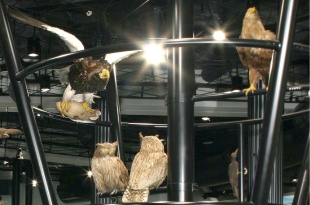
1-18 How Bird Species Adapt
The environment in eastern Hokkaido is diverse, with wetlands, grasslands, forests, and rocky coastlines supporting a broad range of endemic and migratory bird species. Some have long legs and long beaks to hunt for food in wetlands and tidal flats, while others have wide wingspans and sharp talons to snatch up small mammals and fish.
The Japanese crane (tancho; Grus japonensis) and the gray heron (Ardea cinerea) hunt in the wetlands. They use their long beaks to pluck small fish, amphibians, and mammals from the water. Whooper swans (Cygnus cygnus) spend time on the wetlands and lakes around Kushiro, digging for roots with their webbed feet. Predatory birds such as Blakiston’s fish owl have powerful legs and talons that allow them to capture small mammals and fish.
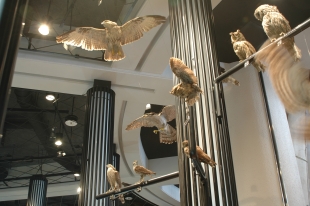
1-19 Eurasian Least Shrew: Japan’s Smallest Mammal
The Eurasian least shrew (Sorex minutissimus hawkeri), also called the Tokyo shrew, is one of the smallest mammals in the world. An endangered species, it measures just 5 centimeters from nose to tail. It lives in the grasslands and wetlands around Kushiro, feeding on insects.
Shrews resemble mice but are more closely related to moles and hedgehogs. The Eurasian least shrew is one of four species of shrew unique to Hokkaido.
The name “Tokyo shrew” arose from a simple labeling mistake. When the Eurasian least shrew was discovered during the Meiji era (1868–1912), a specimen of the shrew was labeled “Ezo,” referring to Hokkaido. However, it was later misread as “Edo,” the old name for Tokyo, and the name stuck.
This English-language text was created by the Japan Tourism Agency.
このページに関するお問い合わせ
生涯学習部 博物館 博物館担当
〒085-0822 北海道釧路市春湖台1番7号 博物館
電話:0154-41-5809 ファクス:0154-42-6000
お問い合わせは専用フォームをご利用ください。
